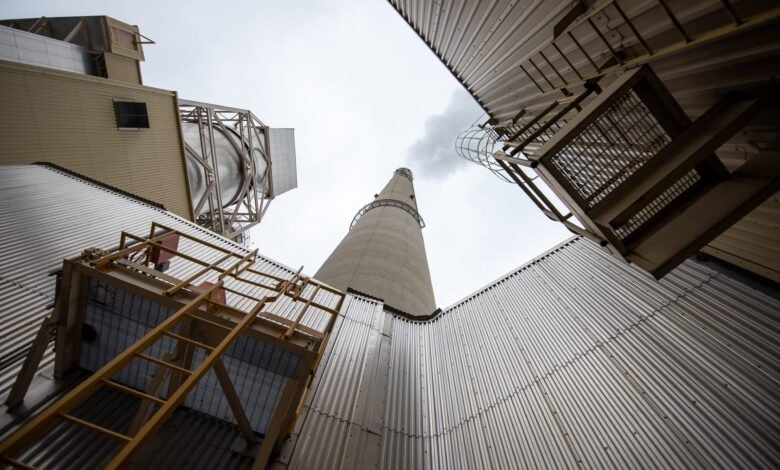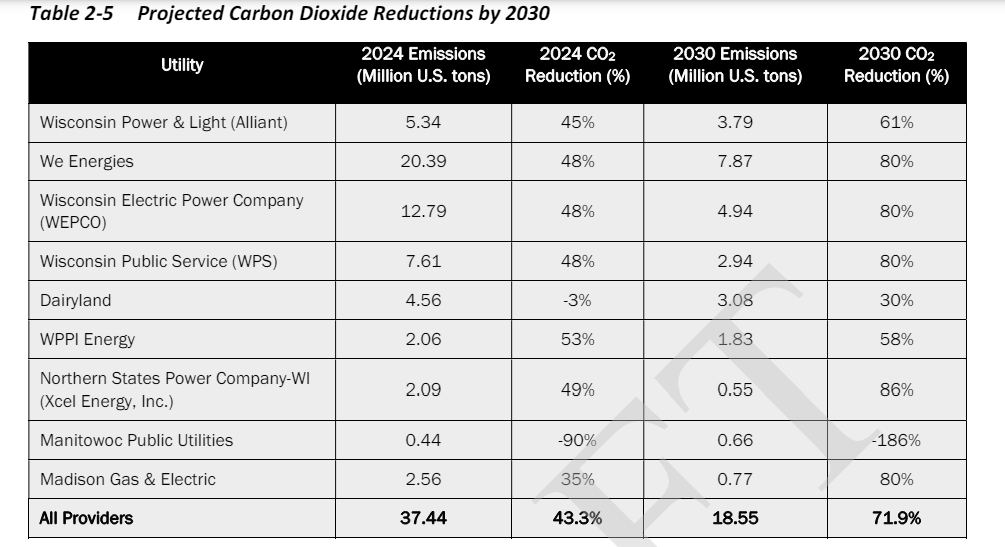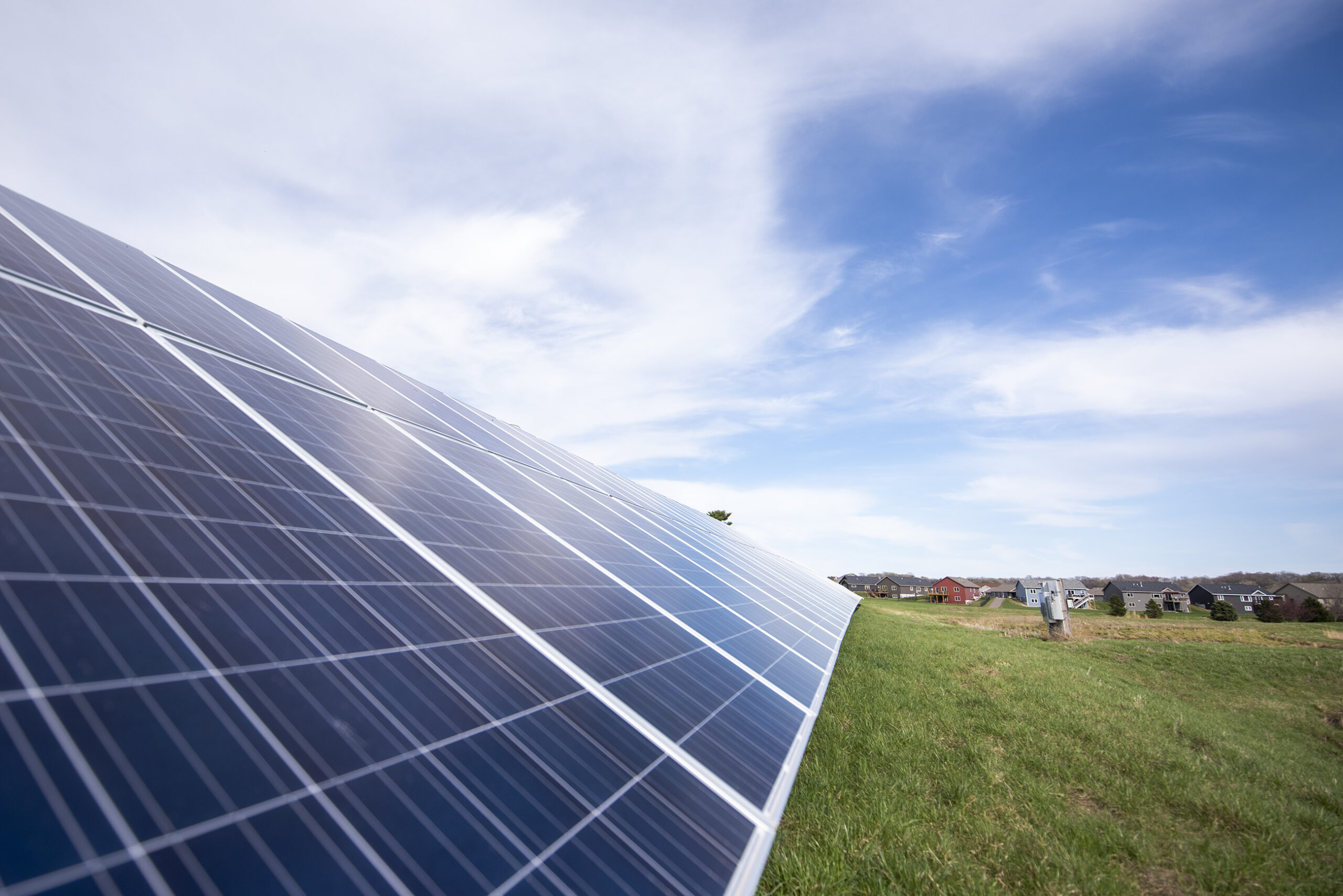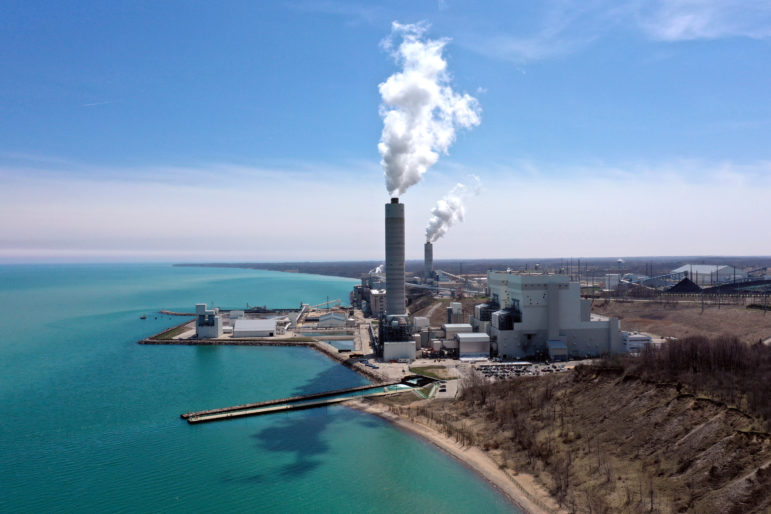Draft PSC report says Wisconsin’s major utilities on pace to meet emissions goals

All five of Wisconsin’s major electric utilities are on pace to hit their carbon reduction goals by the end of the decade, according to a new draft report from the state’s utility regulator.
Every two years, the Public Service Commission of Wisconsin prepares the Strategic Energy Assessment, a report compiling information on electricity demand, the state’s energy mix, affordability and environmental impact. The new draft report is based on data utilities provided to state regulators in fall 2023 as well as historical data.
Two years ago, the draft Strategic Energy Assessment projected four of the five major electric providers would fall short of their goals. But the regulator’s new draft said all major electric utilities are expected to meet their 2030 goals through coal plant retirements, moving to cleaner fuels and adding renewable energy resources.
Stay informed on the latest news
Sign up for WPR’s email newsletter.
For Wisconsin Public Service, We Energies, Xcel Energy and Madison Gas and Electric, hitting their goals means reducing carbon dioxide emissions by 80 percent from 2005 levels by 2030. Alliant Energy, meanwhile, has a goal of a 50 percent reduction in emissions by 2030.
All five major utilities hope to achieve a 100 percent reduction in emissions from 2005 levels by 2050.
While the draft Strategic Energy Assessment’s findings may be encouraging, RENEW Wisconsin Policy Director Andrew Kell said it’s important to understand the projections come from the utilities themselves.
“It’s not too surprising to see utilities own projections in alignment with their own goals that they have provided in public documentation,” he said. “It’s also important to remember that each utility has aspirational goals that are not requirements enforceable by state or federal governments.”

Tom Content, executive director of the Citizens Utility Board of Wisconsin, also cautioned that aspects of the draft report may be out of date, calling it “snapshot” in time. He said it appears the report doesn’t account for energy demand from Microsoft’s planned $3.3 billion data center campus in Mount Pleasant.
“We know that data centers use a lot of power, but we don’t know exactly how much the data centers in Wisconsin are going to use,” Content said. “Forecasts of how much energy demand is going to grow appear to be out of date.”
Utility officials weigh in on emissions progress
Brendan Conway, a spokesperson for We Energies and Wisconsin Public Service, said the utilities are pleased with the progress they’ve made reducing carbon emissions. By the end of 2023, he said, both utilities’ parent company, WEC Energy Group, had reduced carbon emissions by 54 percent from 2005 levels.
On May 31, two coal-fired units at We Energies’ Oak Creek power plant went offline, and the utility remains on track to close the other two units toward the end of 2025, he said.
“There’s a lot of big projects that either will come online or could be coming online in the coming years and it’s all part of the transition,” Conway said. “We remain confident we will meet those aggressive carbon goals.”
Only Xcel and Alliant were projected to exceed their goals, according to the draft report. Xcel is expected to see an 86 percent reduction in CO2 emissions, while Alliant is expected to see a 61 percent reduction.
Brian Elwood, regional vice president in Wisconsin and Michigan for Xcel Energy, said the utility has been making progress reducing emissions since setting carbon reduction targets in 2018. Last year, Xcel surpassed producing half of its energy without carbon. Elwood said the utility is well positioned to hit its 2030 target, but the work isn’t done yet.
“By 2050, we want to have 100 percent carbon-free electricity for all of our operations,” he said. “That’s not just Xcel Energy in Wisconsin. That’s Xcel Energy in the eight states that we serve.”

Jeff Hanson, director of environmental services and corporate sustainability at Alliant Energy, credited the utility’s progress toward reaching its 2030 goal to “strategic investments” in cleaner and more diverse energy sources.
“Our recent construction of nearly 1,100 megawatts of solar generation capacity in Wisconsin is contributing to a cleaner energy future while delivering reliable, cost-effective energy to our customers,” Hanson said in a statement.
Emissions, energy generation mix outlook
This year’s total CO2 emissions from electric providers in the state are estimated to be down 43.3 percent from 2005 levels, according to the draft report.
By the end of the decade, overall statewide carbon emissions from electric utilities are expected to be down nearly 72 percent from 2005 levels.
Kell with RENEW Wisconsin said there’s a risk utilities could get complacent about the clean energy transition. That’s why he said it’s critical that advocates continue to push for wind and solar energy, as well as battery storage.
“We have to have a participatory democracy and energy sector in order to make these goals a reality. It’s up to everybody really to support and yet push each other,” he said.
The PSC’s draft report said coal plants accounted for more than 70 percent of carbon dioxide emissions from utility-owned facilities.
Coal continues to make up the largest share of Wisconsin’s energy generation, but it’s decreased significantly in recent years, according to the PSC draft report. Coal went from about 54 percent of the state’s energy generation in 2015 to 27 percent in 2022, the draft report said.
Natural gas, wind and solar have all grown in the same time frame. Natural gas went from 19 percent of the state’s energy generation to 26 percent, wind increased from 6 percent to 19 percent and solar increased from less than 0.1 percent to 3 percent.
By the end of the decade, the PSC’s draft report estimates 13 percent of the state’s energy generation will come from coal, 28 percent from natural gas, 24 percent from wind and 14 percent from solar.

Conway and Elwood said solar has become more cost effective in recent years, helping accelerate the development of solar farms in Wisconsin.
But even as solar and wind have expanded, clean energy advocates have been concerned about the growth of natural gas usage for energy generation. They’ve also been critical of proposed natural gas investments by utilities.
While natural gas produces roughly half the carbon emissions of coal plants, it releases methane, which has more than 80 times the warming power of carbon dioxide over the span of two decades, according to the United Nations Economic Commission for Europe.
“We have seen recently where natural gas has helped decrease coal fired generation,” said Kell with RENEW Wisconsin. “But at the same time, there is a risk going forward if we’re adding gas to the system — instead of zero-carbon generating resources in combination with battery and other energy storage technologies — that we may ultimately not meet these zero carbon emission goals.”
But Conway and Elwood said natural gas is necessary for ensuring grid reliability for times when the wind isn’t blowing and the sun isn’t shining. They both said natural gas plants could be repurposed to use hydrogen as a fuel source in the future.
“We do have the need for firm dispatchable generation when intermittent sources of power are not available — that’s really important for us,” Elwood said. “It’s important that we provide safe and reliable service for customers and we’re able to provide energy when they need it at the time that they need it.”
Officials with Xcel and We Energies said that getting to an 80 percent reduction in emissions is the easy part. The real challenge, they said, is getting to a 100 percent reduction from 2005 levels.
“We can hit our 2030 goal with technology that exists today, so we’re not counting on something that still has to be developed that doesn’t exist,” Conway said. “That last 20 percent is what people across the industry are really trying to figure out. The good news is there’s a lot of innovation, a lot of energy (and) a lot of investments across the country going into new ways to reduce emissions.”
Editor’s note: Alliant Energy, the Citizens Utility Board of Wisconsin and RENEW Wisconsin are sponsors of Wisconsin Public Radio.
Wisconsin Public Radio, © Copyright 2024, Board of Regents of the University of Wisconsin System and Wisconsin Educational Communications Board.
Source link

